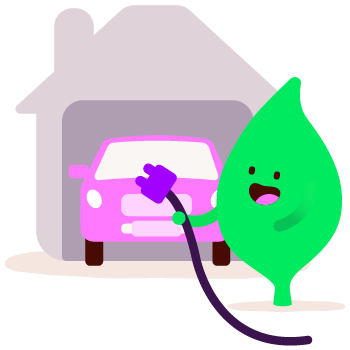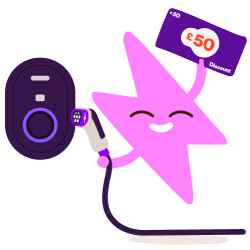Next Drive: Fixed EV tariff for home charging
What is an EV tariff?
Unlike conventional energy tariffs, EV tariffs are designed to offer flexibility and cost-effectiveness for people who rely on their electric vehicles for daily transport - whether that’s driving to work, taking the kids on the school run or using your vehicle throughout the day.
We believe that if you can work out the right balance you can make an informed decision about your energy use and expenses for your EV charging.

Our Next Drive EV tariff gives you:
Lower-priced electricity at 7.5p per kWh when you charge between 12am and 6am.1
Fixed energy prices for one year.
No exit fees.
1 Next Drive Fixed v10 offers fixed priced overnight EV charging 7.5p/kWh between 12am and 6am versus Next Flex standard variable tariff at 25.73p/kWh (national average and will vary by region). Information correct as of 6 May 2025. Based on all dedicated “like-for-like” EV market tariffs from suppliers excluding tariffs with bundled products or add-ons . Based on dual fuel customers, paying by Direct Debit. Terms and conditions apply.
Am I eligible for the Next Drive tariff?
To be eligible for our Next Drive tariff you need to have a smart meter that can send us half hourly updates on your energy use. This is so we can bill you for the right rate.
If you have a smart meter already, you can check how often you send us your data in your online account.
Don’t have a smart meter yet? If your home is eligible to have one, we’ll install it free of charge.
Get a smart meter

Get supercharged benefits with Zoom EV.
As an E.ON Next customer, you can get a free 1 year subscription to Zoom EV, an online platform that gives you benefits and discounts on things like public charging, parking, car hire, and much more.4
4 As an E.ON Next customer, you could get a one year’s subscription to Zoom EV. By registering you give consent for your details to be shared with Zoom EV and for Zoom EV to contact you regarding this offer. Zoom EV is a third party vendor and will not share your information with other third parties.
Two-rate and single-rate EV tariffs.
When you start to shop around, you will generally find EV energy tariffs fall into one of two categories:
There’s the “dynamic two-rate tariff”, which charges different prices for peak and off-peak hours. You’ll normally find that the off peak prices are much lower in these.
Then there’s the straightforward “single-rate tariff”, which comes with consistent pricing throughout the day. These are not so common and you won’t normally get the big discount during off peak charging that you do with two-rate tariffs. But equally, you won’t be charged a top rate during peak hours.
Of course, the choice is yours, and you should choose one that fits in with your charging habits and lifestyle. Maybe you’re after the flexibility and potential cost savings during off-peak hours.
Alternatively if you want the freedom to charge during peak hours without being penalised for it, then a single rate tariff might be best for you.
When is it cheaper to charge my EV with Next Drive?
With Next Drive, you’ll get lower electricity prices for charging your electric vehicle at night, specifically between 12 am and 6 am off-peak hours. While you can charge your vehicle during the day, the rates will be closer to standard electricity rates.

Get the E.ON Drive Comfort app.
E.ON Drive Comfort is the ultimate app for easy out-of-home EV charging. With access to over 20,000 charge points in the UK, and over 500,000 across Europe, our app ensures you're always powered up, wherever your journey takes you.
Pay for what you use with our flex plan, billed monthly, or subscribe for just £5.99 a month and received 10% off charge prices. Both options are commitment free. You will be billed monthly.3
3 All prices include VAT. Additional parking fees apply depending on the station operator. The price that is displayed in the app before the loading process begins always applies. Additional parking fees apply in the flexible charging and E.ON Drive tariffs if the respective charging station operator charges a parking fee. The respective maximum charging time and the costs if the maximum charging time is exceeded are displayed to you in the E.ON Drive Comfort app before the respective charging process is initiated.
Can I charge my EV on the standard variable tariff?
The short answer is yes, you can charge your vehicle on the standard variable tariff (SVT). However, there are a few things you’ll want to keep in mind:
Typically, SVTs can be more expensive than EV-specific tariffs. This is because they do not offer any specific benefits for EV charging, such as lower rates during off-peak hours.
You may be unable to take advantage of off-peak electricity prices if you charge your vehicle at night. This is because some electricity suppliers only offer off-peak rates for certain types of tariffs, such as dual-fuel.
Now if you only charge your car occasionally, if you only drive your vehicle for short trips or if you are happy to use (and have access to) public charging points, you may not feel the need for a dedicated EV tariff.
But then again, why would you not want to take advantage of everything an EV tariff has to offer, when switching to one is so easy?
EV tariffs and price caps.
Budgeting for charging your electric car is more straightforward with an EV fixed energy tariff. With a variable rate tariff, the maximum you pay per unit of electricity (kWh) is set by the price cap.
However, we all know from recent years that the price cap can go up as well as down. And this can lead to some uncertainty - not helpful when you’re working out a household budget.
So, if you want to enjoy predictability and protection against sudden spikes in energy prices, a fixed EV tariff is probably the best way to go. It provides peace of mind and stability for EV owners when you budget for energy costs related to electric vehicle charging.
How do I switch to an EV tariff?
Switching to an EV energy tariff like E.ON Next Drive is usually straightforward. Here's a step-by-step guide:
Assess your EV charging needs. Work out your average daily or weekly electricity consumption. This will help you choose the most suitable EV tariff based on your charging patterns.
Compare EV tariffs. Utilise price comparison websites or energy supplier websites to compare various EV tariffs. Consider factors like unit rates, standing charges, and any additional benefits or incentives (like our own £50 off home charger offer).
Check eligibility. Make sure you meet the eligibility criteria for the EV tariff you've chosen. This may involve having a smart meter, or a compatible EV charger.
Contact your current energy supplier. Inform your current supplier of your intention to switch to an EV tariff. They may provide assistance with the switching process.
Provide necessary information. Provide the new EV supplier with your account details, including your meter number, payment information, and any additional documents they may require.
Finalise the switch. Confirm the switching date and ensure you receive any necessary notifications from your current and new suppliers.
Monitor your energy bills. To make the most of your new EV tariff, monitor your energy bills to ensure you're paying less as expected.
Here are some additional tips for switching to an EV energy tariff.
Consider peak and off-peak rates if your EV charging patterns allow for flexibility.
Check for any renewable energy credentials or environmental commitments associated with the EV tariff.
Take advantage of any government incentives or subsidies available for EV charging.
How do I schedule my car to start charging at the cheapest time to use electricity?
There are several ways to set the charging times for your electric car. Helpfully the cheaper charging time for our Next Drive tariff is the same every night, so you only have to set the charging time once.
You can schedule your charging by:
Most electric cars allow you to set the charging times in the infotainment system.
Your car may have a separate app to schedule charging.
You can also set your car to charge from a certain time or to the charge the battery to a set level so it won't start charging straight away.
You can still plug the car in at off peak times, it just won’t charge the car unless you set it to do so. And, you can still charge at other times to off-peak, it'll just cost you a bit more.

A home EV charger with £50 off.
E.ON Next customers can enjoy a nifty discount when they install an electric vehicle charger at home. T&Cs apply.
More on electric vehicles with E.ON Next.
Curious about making the switch to an electric vehicle? Explore useful information on EV charging, find and use public chargers, plan long journeys, estimate charging times, and compare EV models to make informed decisions for your journey.
Want to know more about public chargers?
Planning a long journey in your electric car?
Ready to charge your electric vehicle?
How much does it cost to charge an EV?
Electric cars vs petrol cars.
Is it worth moving to an EV tariff?
Do I need a special cable to charge my EV?
Do you need planning permission to install a charger for your EV?
Do I need a qualified installer to install my home charger?
Terms and conditions.
†† Lower-priced electricity 7.5p/kWh when you charge between 12am and 6am.
† Off peak rates apply from 12am to 6am daily under the Next Drive Fixed tariff for whole home electricity usage, including EV charging. Information correct at time of send (5 February). Market conditions may change. Terms and conditions apply.
^ £3 calculated as charging an electric vehicle battery of 40kWh at 7.5p/kWh. Off-peak rate available between 12am - 6am on the Next Drive tariff. Rate accurate as of 16 April 2025. Direct Debit only. Smart meter with half hourly consent required. Actual costs may vary depending on vehicle battery size and charging efficiency.
+ Tariff saving calculations assume an electric vehicle driving 8,000 miles a year at 3.33 miles per kilowatt, charging 7.5p per kWh during off-peak Next Drive Fixed v10 tariff hours (12am-6am); compared to charging at 25.73p/kWh (national average and will vary by region) standard variable tariff rate from 1 April 2025 which is equivalent to £305 saved. T&Cs apply.
* Information correct as of 4 October 12am. Based on all dedicated “like-for-like” EV market tariffs from suppliers with a customer base of more than 1 million accounts. Based on dual fuel customers, paying by Direct Debit and consuming medium energy usage as defined by Ofgem’s Typical Domestic Consumption Values (TDCV), (2,700kWh of electricity and 11,500kWh of gas per year, plus an additional 1,976kWh of electricity for car charging), at an average for all 14 regions.